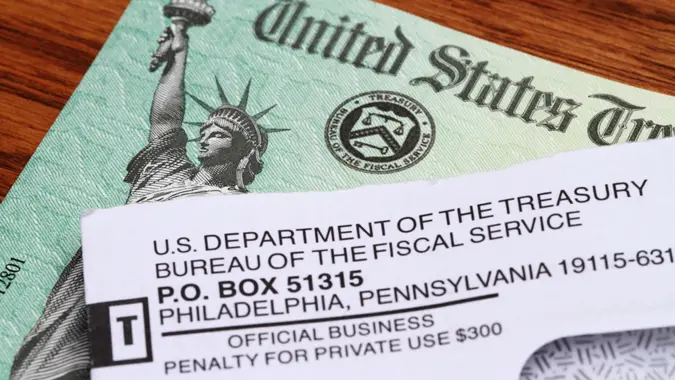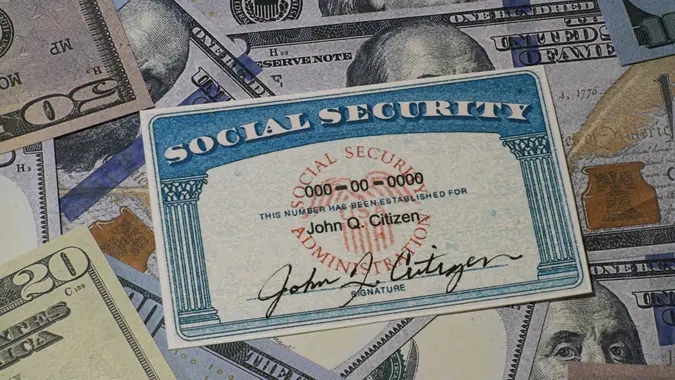5 Things the US Should Do Now To Tackle Looming Social Security Cuts, According to Experts

Commitment to Our Readers
GOBankingRates' editorial team is committed to bringing you unbiased reviews and information. We use data-driven methodologies to evaluate financial products and services - our reviews and ratings are not influenced by advertisers. You can read more about our editorial guidelines and our products and services review methodology.

20 Years
Helping You Live Richer

Reviewed
by Experts

Trusted by
Millions of Readers
In July, the Board of Trustees of the Federal Old-Age and Survivors Insurance (OASI) and Federal Disability Insurance Trust Funds released its 2025 annual report. It projected that the trusts that fund Social Security will be depleted by 2033, leaving only payroll taxes to provide promised benefits — and it won’t be enough, to the tune of nearly one dollar in four.
Shortly after, the nonprofit, nonpartisan Committee for a Responsible Federal Budget released an analysis of the Trustees report that predicts a 24% benefits cut in late 2032. That equates to an $18,100 reduction in annual payments to the average retired couple on Social Security — but only if Congress doesn’t act to avert the crisis in the next seven years.
“The projected depletion of the Social Security OASI Trust Fund by 2033 represents not just a budgetary issue but a significant financial planning challenge for millions of Americans,” said Margaret M. Koosa, CEO of The Alchemists wealth advisory firm. “A reduction in benefits would materially impact retirement security, particularly for middle-income households who rely heavily on Social Security as a foundational source of retirement income.”
Here’s what lawmakers should do now to prevent the looming crisis.
Gradually Raise the Full Retirement Age
According to the Social Security Administration (SSA), the average life expectancy for babies born at the dawn of Social Security in the 1930s was just 58 for men and 62 for women, yet the full retirement age (FRA) was 65. Today, the full retirement age for those born in 1960 or later is 67, yet the gender-combined life expectancy is approaching 80 — and Social Security was never designed to support decades of retirement.
“As life expectancy has increased, so too should the age at which full benefits are received,” said Koosa, whose IRMAACP designation indicates a certified expertise in Social Security. “Similar to the phased-in changes to required minimum distributions, implementing a phased-in increase of the FRA to age 68 or 69 would align benefits more closely with demographic realities, without disrupting the retirement plans of near-retirees.”
Raise or Eliminate the Payroll Tax Cap
In 2025, the payroll tax cap is $176,100. Any income over that limit is not subject to the 6.2% tax that funds Social Security, which spares high earners from paying into the program with some or most of their income.
“Lifting or eliminating this cap — potentially coupled with a doughnut hole structure where earnings between certain thresholds are excluded — could bring substantial additional revenue into the system while preserving, potentially enhancing, fairness,” said Koosa.
Wealth consultant Catherine Valega, CFP, EA, CAIA, founder of Green Bee Advisory, concurs.
“I know the current administration doesn’t want to tax the rich,” she said, referencing the omission of a payroll tax cap increase from President Donald Trump’s One Big Beautiful Bill Act. “But having the Social Security taxes on wages capped at a relatively low $176,100 is just stupid.”
Implement Progressive Benefit Adjustments
Social Security is an earned right, not a means-tested benefit, meaning every qualifying earner receives benefits no matter how high their income or how valuable their assets.
That might have to change.
“Even though means testing is a controversial, but potentially effective, measure, high-income retirees could receive modestly reduced benefits or slower cost-of-living (COLA) adjustments, preserving full benefits for lower- and middle-income recipients who depend on them most,” said Koosa.
Diversify Funding Sources
Like individuals trying to make ends meet, massive federal spending programs like Social Security are most likely to prosper with multiple revenue streams. In short, Social Security could benefit from a side hustle.
“Beyond the payroll tax, policymakers could explore alternative funding mechanisms — such as applying Social Security taxes to certain forms of investment income — to modernize the program’s revenue base in an economy increasingly driven by non-wage compensation,” said Koosa.
Additionally, just as raising the full retirement age could shore up the OASI trust, so, too, might increasing the earliest age at which recipients become eligible.
“Why 62 when we don’t get Medicare until 65?” said Valega.
Adjust the Delayed Retirement Credit
The SSA reduces benefits for those who enroll before full retirement age, but it increases them for those who wait until after age 67 with delayed retirement credits (DRCs). That, too, might have to change.
“Currently, if someone reaches FRA and delays taking their Social Security benefit, their benefits grow by 8% per year until age 70,” said Koosa. “This could be reduced from 8% to 5% or 6%, which would decrease the cost of delayed claims.”
Koosa suggests capping credits for high earners, tying the DRC to interest rates or life expectancy, or eliminating credits for spousal and survivor beneficiaries.”
Like all potential remedies outlined here, reducing credits would be painful and is therefore political poison. Even so, something has to give in the next seven years.
“While none of these changes are politically simple, the longer the government waits, the more disruptive the eventual solutions will be,” said Koosa. “Proactive policy change now could help restore confidence in the program.”
 Written by
Written by  Edited by
Edited by 

























